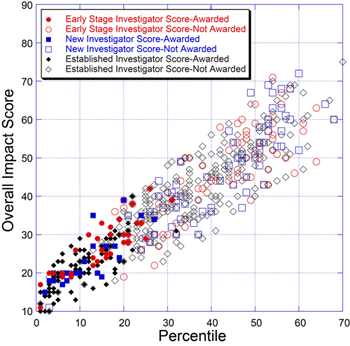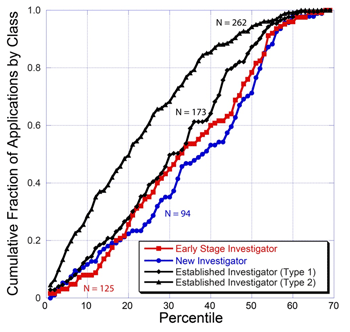We’ve issued a funding opportunity announcement (FOA) (PAR 22-180) to provide sustained support for biomedical research through our Maximizing Investigators’ Research Award (MIRA) program. This FOA allows applications from eligible NIGMS-funded investigators and from New Investigators proposing research within the scientific mission of NIGMS. The FOA also allows renewal applications from all eligible MIRA grantees (established and ex-Early Stage Investigators). Program directors (PDs)/principal investigators (PIs) who are currently Early Stage Investigators (ESIs) should apply through the ESI MIRA FOA and not to this announcement.
Continue reading “NIGMS Continues and Expands Its MIRA Program”Tag: Established Investigator
NIGMS Continues Its MIRA Program
We’ve issued a funding opportunity announcement (FOA) PAR-19-367 to maintain continued support of our Maximizing Investigators’ Research Award (MIRA) program. Under this new FOA, investigators with an active NIGMS R35 grant (both early-stage and established investigator MIRA) can submit renewal MIRA applications, and investigators with a single-PI R01-equivalent NIGMS award (DP1, DP2, R01, R37, SC1) can submit new MIRA applications.
Continue reading “NIGMS Continues Its MIRA Program”Supplements for MIRAs: Clarifying the Policy
UPDATE: Consult the MIRA webpage or your program officer for the current notices of funding opportunities.
Since supplemental grant funding comes in a variety of flavors, with different purposes, it’s not surprising that there’s confusion about which kinds of supplements MIRA grantees may apply for and which they may not. Here’s a quick run-down.
Continue reading “Supplements for MIRAs: Clarifying the Policy”Planning to Apply for an NIGMS Established Investigator MIRA? Points to Consider
When NIGMS issued PAR-17-094, Maximizing Investigators’ Research Award (R35), in December 2016, we opened the established investigator MIRA mechanism to all NIGMS grantees whose single-PI R01-equivalent grants were set to terminate in the same or subsequent fiscal year as the MIRA application. The purpose of this post is to remind you of important points to keep in mind if you are eligible to apply for a MIRA. Before applying, we strongly encourage you to contact your program director, who can advise you on whether MIRA is the best funding program for you and can help estimate a project budget if your application does well in peer review.
Some key points to know if you are considering applying for a MIRA grant:
Continue reading “Planning to Apply for an NIGMS Established Investigator MIRA? Points to Consider”
First Awards Issued in MIRA Pilot Program
We have begun making grant awards resulting from responses to RFA-GM-16-002 (R35), the Maximizing Investigators’ Research Award (MIRA) pilot program. Out of the 179 applications we received, we have so far authorized 123 awards. The median yearly direct costs for these grants is $399,842, and the mean is $405,884. For comparison, the median yearly direct costs for an NIGMS R01 in Fiscal Year 2015 was $210,000, and the mean was $237,254. On average, the budgets of these MIRAs to established investigators were reduced by 12% relative to the investigators’ recent NIGMS funding history. As described in the funding opportunity announcement (FOA), the budget reductions were in exchange for the benefits of the program: a 5-year award instead of the standard 4-year one, increased flexibility to follow new research directions, increased funding stability and decreased administrative burden. We will use the funds freed up through this trade-off to support other investigators and improve the distribution of NIGMS funding. It will take time for the full benefits of the program to individual investigators and the research community to become clear.
You can find more information about these awards on NIH RePORTER by entering RFA-GM-16-002 in the FOA field; however, the record of funded grants will not be complete until the end of Fiscal Year 2016. Because merging an investigator’s previous funding into a single award presents a variety of complications, in some cases the first-year budget of the MIRA is lower than the eventual funding level will be. This is frequently the case when the principal investigator (PI) was part of multi-PI grants that will be allowed to end before all NIGMS funding for the investigator is put on the MIRA or when the PI had already received funds from NIGMS in the current fiscal year.
We will begin making awards for the new and early stage investigators MIRA (RFA-GM-16-003) after the May 19-20 meeting of the National Advisory General Medical Sciences Council.
You can find additional information about the program on our MIRA web page.
MIRA Program Continues with New FOA
UPDATE: The March 21 Webinar slides and video, the eligibility flowchart and answers to frequently asked questions have been posted.
We just issued a funding opportunity announcement (FOA) for the second year of our Maximizing Investigators’ Research Award (MIRA) program. This FOA continues pilot testing of the MIRA concept with a small cohort of investigators. For this reason, the current FOA is for established investigators, although we’re working on plans to expand the program to allow all NIGMS-funded investigators to apply. Applications are due by May 20, 2016. The earliest start date is April 2017.
We have made a number of modifications to the FOA based on what we learned in the first round. In particular, we have clarified the text in a number of places to avoid confusion by applicants and their institutions. We have also broadened the MIRA eligibility window to include later R01 renewal dates to enable more investigators to apply and for more of them to have the possibility of submitting renewal applications for their R01s if their MIRA application is unsuccessful or if they choose to decline an award. Therefore, please read the new FOA carefully if you are considering applying for this opportunity.
We’ll hold a webinar on Monday, March 21, from 12:30-1:30 p.m. EDT to discuss this FOA, the status of the first group of awards and our future plans for the program. You’ll be able to access the webinar at https://face2face.nih.gov/anthony.eam/JGQLDQ9J and submit questions via the chat function.
MIRA Program Launches with First FOA
We have just issued the first funding opportunity announcement (FOA) in the pilot of our new Maximizing Investigators’ Research Award (MIRA) program. The development of this program was greatly informed by responses to our request for information, which I summarized in a previous Feedback Loop post.
The goal of this FOA is to test the MIRA concept under well-controlled conditions with a small group of investigators. We’re initially targeting established investigators who have received two or more R01-equivalent awards or a single award of $400,000 or more in direct costs from NIGMS in Fiscal Year 2013 or 2014, and who have at least one grant expected to end in Fiscal Year 2016 or 2017. We think that this approach will help these investigators transition smoothly from their current grants to MIRA support. In the future, we plan to issue MIRA FOAs for additional groups of investigators, and if the pilot is successful we will open the program to any investigator working on research questions related to the mission of NIGMS.
If you’re eligible for this FOA and on the fence about applying, consider that MIRA awards:
- Will be for 5 years instead of the current NIGMS average of 4 years,
- Will continue support for other research currently funded by NIGMS without requiring a separate renewal application,
- Will provide flexibility to pursue new ideas and opportunities as they arise,
- Will increase funding stability, and
- Will reduce time spent managing multiple grant awards and writing grant applications.
We’ll post additional information, including answers to frequently asked questions, on the NIGMS MIRA Web page.
NOTE: The FOA lists the earliest award date as December 2016. This is an error. The earliest award date is actually April 2016.



